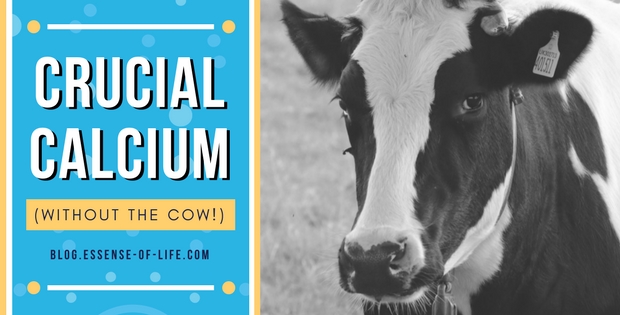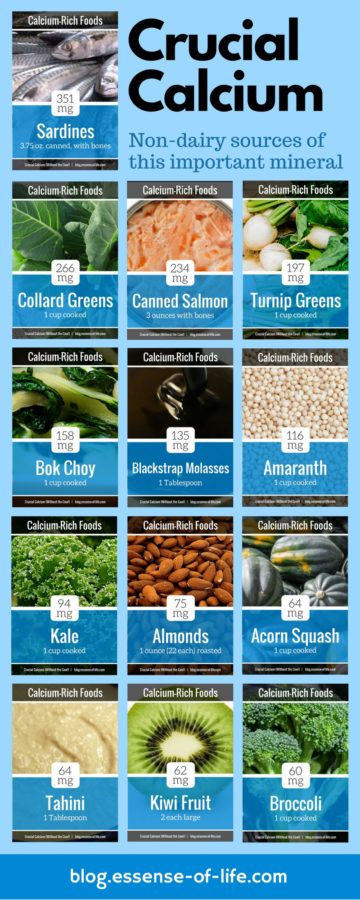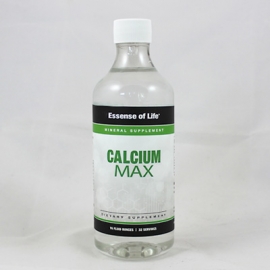Crucial Calcium (Without the Cow!)

Why is Calcium So Important?
Crucial calcium is the most abundant mineral in the body and is a major component of bones and teeth, where 99% of our body’s calcium resides. The skeleton is actually a reserve of calcium from which the body can draw upon to maintain normal serum calcium in case of inadequate dietary intake. But calcium has many other vital functions in the body besides its well-known benefits for bone health.
Calcium is necessary for constriction and relaxation of blood vessels (vasoconstriction and vasodilation), nerve impulse transmission, muscle contraction, and the secretion of hormones like insulin. Muscle and nerve cells contain voltage-dependent calcium channels in their cell membranes that allow for rapid changes in calcium concentrations. When a nerve impulse stimulates a muscle fiber to contract, calcium channels in the cell membrane open to allow calcium ions into the muscle cell. In this role, calcium is crucial for the proper functioning of the electrical conduction system of the heart.
The Recommended Daily Allowance of calcium for adults is 1,000-1,200 mg per day, with upper limits of 2,000-2,500 mg per day. Consuming too much calcium can lead to increased risk of kidney stones, heart disease, and more due to calcium accumulation in the body.
What Are Some Causes of Low Calcium Levels?
• Poor calcium intake over a long period of time, especially in childhood
• Dietary intolerance to foods rich in calcium
• High sodium intake, which increases calcium loss in urine
• Hormonal changes, especially in women
• Hormonal disorders such as hypoparathyroidism
• Removal of parathyroid gland tissue as part of surgery to remove the thyroid gland
• Certain genetic factors
• Low levels of vitamin D, which makes it harder to absorb calcium
• Medications which decrease calcium absorption
• Medications, such phenytoin, phenobarbital, rifampin, corticosteroids, and drugs used to treat elevated calcium levels
• Medications which interact negatively with calcium supplements
• Certain chemotherapy drugs
• Pancreatitis
• Hypermagnesemia (excessive magnesium levels)
• Hypomagnesemia (deficient magnesium levels)
• Hyperphosphatemia (excessive phosphorus levels)
• Septic shock
• Massive blood transfusions
• Renal failure
What are the Symptoms of Severe Calcium Deficiency or Hypocalcemia?
• Headaches
• Visual Disturbances
• Hallucinations
• Neuromuscular Irritability
• Numbness or Tingling in the Hands, Feet, and Face
• Muscle Cramps
• Abnormal Heart Rhythms
• Confusion
• Memory Loss
• Depression
• Dry Itchy Skin
• Eczema
• Psoriasis
• Weak Brittle Nails
• Dental Cavities
• Osteoporosis (low bone density)
What are the Best Dietary Sources of Calcium?
Many foods are rich in calcium, but not all calcium is absorbable. Here are the top non-dairy foods with the highest amount of absorbable calcium per serving:
#1 Sardines, canned with bones (3.75 ounces): 351 mg
#2 Collard Greens, cooked (1 cup): 266 mg
#3 Salmon, canned with bones (3 ounces): 234 mg
#4 Turnip Greens, cooked (1 ounce): 197 mg
#5 Bok Choy, cooked (1 cup): 158 mg
#6 Blackstrap Molasses (1 Tablespoon): 135 mg
#7 Amaranth Grain, cooked (1 cup) 116 mg
#8 Kale, cooked (1 cup): 94 mg
#9 Almonds, roasted (1 ounce / 22 each): 75 mg
#10 Acorn Squash, cooked (1 cup): 64 mg
#11 Tahini (1 Tablespoon): 64 mg
#12 Kiwi Fruit (2 Large): 62 mg
#13 Broccoli, cooked (1 cup): 60 mg
How Do I Increase Calcium Absorption?
Even though a food is rich in calcium, it doesn’t necessarily mean that the calcium is fully available to the body for absorption and assimilation. Additional nutrients are needed in order for that calcium to be utilized. Calcium relies on vitamin D, magnesium, and vitamin K2 to function properly. Vitamin D and magnesium are both required for optimal calcium absorption. Vitamin D increases the rate calcium is absorbed into your blood while magnesium is used to convert vitamin D into its active form so that it can be used in calcium absorption. One study showed that people with adequate vitamin D levels absorbed 400% more calcium from the foods they ate than those who were deficient in vitamin D! Without vitamin D and magnesium, calcium cannot be absorbed correctly. Vitamin K2 is also important for calcium synthesis. It helps move calcium into the bones and teeth, while also helping to keep it out of areas where it shouldn’t be, such as in your arteries.
Certain foods which are naturally high in calcium contain oxalic acid, also known as oxalate, which is a potent inhibitor of calcium absorption due to its ability to bind to calcium to form an insoluble compound. Foods high in oxalic acid include lambsquarters, beet leaves, purslane leaves, spinach, swiss chard (leaves & stalks), rhubarb, parsley, amaranth leaves, and sorrel. When choosing foods for their calcium content, instead choose foods which are low in oxalic acid such as dandelion greens, most fruits, kale, watercress, escarole, mustard greens, turnip greens, broccoli, tomatoes, asparagus, and cabbage.
To maximize calcium absorption in the body, you will also want to avoid a diet high in sodium and phosphorus. Sodium increases loss of calcium in the urine, in part due to the competition between sodium and calcium for reabsorption in the kidneys. Phosphorus, found in protein-rich foods, sodas high in phosphoric acid, and food additives high in phosphates, also increase calcium excretion and may have an adverse affect on bone health.
Why Should I Choose Non-Dairy Sources of Calcium?
When it comes to calcium, most people immediately turn to milk and dairy as the go-to way to increase intake of this important mineral. This is because years of the famous Got Milk? advertising campaign, which featured celebrities sporting milk mustaches as an endorsement of the health benefits of dairy. These ads have conditioned us to believe that we must eat dairy products in order to get the crucial calcium that we need for strong healthy bones and teeth – but that couldn’t be further from the truth. There are many foods that are just as high (if not higher) in calcium than dairy products, and more bioavailable too.
There are many problems with turning to dairy products for crucial calcium. First of all, many people are allergic or intolerant to dairy. It is estimated that up to half the population may respond negatively in some way to the intake of milk-based foods. In addition, dairy sources of calcium are high in fats, may be full of additives and sugars, and if not organic, can even contain hormones and antibiotics from modern dairy farming practices. In addition, many dairy products must be fortified with vitamin D in order to make the calcium they contain even usable. Dairy should never be our sole source of calcium intake.
Calcium is a mineral which, like all minerals, if found in the soil. Plants absorb these minerals into their roots and assimilate them into their structure. Animals such as cows get their calcium by consuming calcium-rich plants in their diet. The real source of calcium is found right beneath our feet! The calcium content of many calcium-rich plants is actually more bioavailable than the calcium found in milk. Many natural foods also contain the magnesium, vitamin D, and vitamin K that calcium needs to increase its absorption and bioavailability. For example, fatty fish with bones are both high in calcium as well as vitamin D, and leafy greens are an excellent source of vitamin K, which makes both of these excellent sources of crucial calcium – without the cow!
Crucial Calcium (Without the Cow!): 13 Dairy-Free Sources of this Important Mineral

Liquid Ionic Calcium Max Supplement
Liquid Ionic Calcium Magnesium Supplement
Share This Article With Someone You Know
Research Sources
• Essense of Life Calcium Health Topic
• How to Get Enough Calcium Without Dairy
• Signs and Symptoms of a Calcium Deficiency
• Hypocalcemia (Calcium Deficiency Disease)
• Questions About Oxalic Acid
• Milk Myth: Why You Don’t Need Dairy for Calcium
• Calcium – Linus Pauling Institute Micronutrient Information Center
• What You Need to Know About Vitamin K2, D and Calcium
• Vitamin K Sources and Benefits
• Self Nutrition Data
This article is copyright ©2018 Essense of Life. All rights reserved. Do not copy without permission.






Facebook Comments